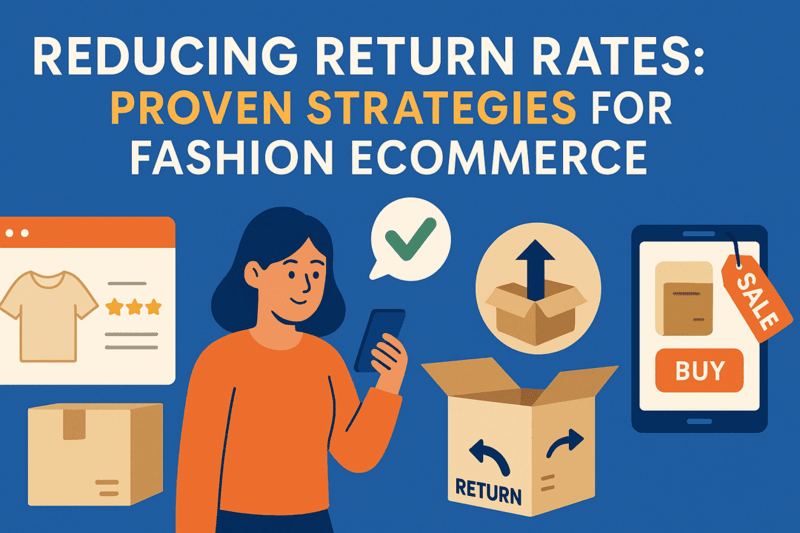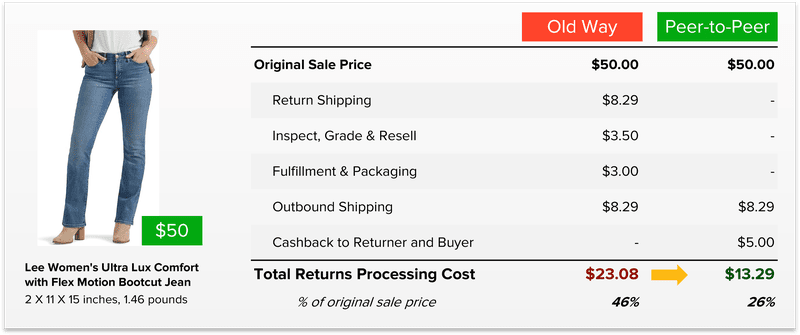How To Reduce Returns In Ecommerce: Proven Strategies for the Fashion Category

Last updated on April 25, 2025

In this article
 11 minutes
11 minutes
High return rates are a significant challenge for fashion ecommerce businesses. While returns are an unavoidable aspect of online shopping, managing ecommerce returns effectively is crucial for maximizing profitability, customer satisfaction, and operational efficiency. The average ecommerce return rate typically falls between 16.9% and 30%, posing substantial challenges and costs for online retailers. This article explores strategies that can help fashion retailers reduce returns, enhance the customer experience, and optimize their business operations.
Introduction to Reducing Ecommerce Returns
Reducing ecommerce returns is crucial for online retailers to maintain customer satisfaction, improve profit margins, and enhance their overall ecommerce business. Ecommerce returns can be a significant challenge for online stores, resulting in additional costs, labor, and potential damage to their reputation. By understanding the reasons behind ecommerce returns and implementing effective strategies, online retailers can minimize returns, prioritize customer satisfaction, and encourage repeat business.
Returns are an inevitable part of online shopping, but they don’t have to be a drain on your resources. By focusing on the root causes of returns and addressing them proactively, you can create a more efficient and customer-friendly returns process. This not only helps in reducing the number of returns but also in building a loyal customer base that trusts your brand.
Effective return management starts with setting clear customer expectations. Accurate product descriptions, high-quality images, and detailed size guides can help customers make informed purchasing decisions, reducing the likelihood of returns due to sizing issues.
In the following sections, we will explore various strategies to reduce returns, including improving product descriptions, offering virtual try-ons, enhancing size guidance, streamlining the returns process, and providing excellent customer service. By implementing these strategies, online retailers can not only reduce returns but also improve customer satisfaction and drive repeat business.
Why Are Return Rates So High in Fashion Ecommerce?
The fashion industry often sees some of the highest ecommerce return rates, with rates hovering around 30%. Understanding the underlying causes of these returns is essential for implementing strategies that can mitigate their impact. Some common reasons for high return rates in fashion ecommerce include:
Sizing and Fit Issues
The most frequent cause of returns in fashion ecommerce is sizing and fit problems. Online shoppers cannot physically try on items before purchasing, which leads to misjudgments about size, fit, and comfort. Inaccurate size charts or inconsistent sizing across brands only add to the confusion, leading to increased return rates and dissatisfaction with customer orders.
Product Expectations vs. Reality
When customers receive items that don’t match their expectations in terms of color, quality, or overall appearance, they’re more likely to initiate a return. An accurate product description is essential in setting these expectations, as discrepancies between the online images and the actual product are a significant contributor to this issue.
Change of Mind or Buyer’s Remorse
Many returns happen when customers regret their purchase after receiving the product. This impulse buying behavior, a common aspect of customer behavior, can lead to returns once the buyer has time to reconsider their decision.
Shipping and Delivery Problems
Delays in delivery, damaged packaging, or order fulfillment mistakes also contribute to returns. Fashion items, particularly delicate materials like silk or wool, are especially vulnerable to damage during shipping, which can trigger a return request.
By identifying the key reasons behind high return rates, fashion retailers can begin to take actionable steps to reduce them. Monitoring shipping company interactions is crucial to ensure that orders are delivered to the initially provided address, as any discrepancies could indicate potential fraudulent activity and lead to returns. Below are several proven strategies that can help minimize returns while boosting customer satisfaction.
Proven Strategies to Reduce Return Rates in Fashion Ecommerce
Improve Product Descriptions and Visuals
Accurate product descriptions, high-quality images, and a focus on product quality are essential for setting the right expectations. When customers know exactly what they’re purchasing, they’re less likely to return the item.
Why It Works:
Detailed product descriptions help customers understand key aspects like material, size, fit, and style. High-quality images from multiple angles, including close-ups, allow online shoppers to visualize the product in a more realistic way. Product videos or 360-degree views can also be highly effective in providing a comprehensive look at how an item fits and moves.
Example: Zara provides detailed product descriptions alongside high-quality visuals and videos, which helps customers make more informed decisions and reduce returns.
Pro Tip:
Use product descriptions that include measurements, fabric composition, and care instructions to give customers a complete understanding of what they’re purchasing. Include whether items are expected to shrink when washed, for example.
Offer a Virtual Try-On Experience
Virtual try-ons can significantly reduce the uncertainty customers feel when buying fashion items online, thereby enhancing the customer experience. By offering augmented reality (AR) tools, online retailers can help customers virtually “try on” items before purchasing.
Why It Works:
AR technology enables customers to see how a piece of clothing will look on their own body, reducing the chances of sizing and fit-related returns. Virtual try-ons help customers make better decisions and feel more confident in their purchases.
Example: ASOS and Zara have integrated AR tools and virtual fitting rooms, allowing customers to see how garments fit based on their body type. This feature enhances the overall customer experience and helps to reduce returns.
Improve Size Guidance and Fit Recommendations
Confusion surrounding sizing often leads to returns. Many ecommerce stores use different sizing standards, which can leave customers unsure about what will fit them best. Accommodating different customer preferences by offering more accurate size guidance and personalized fit recommendations can reduce these issues.
Why It Works:
Providing detailed size charts and offering fit recommendations based on customer data can significantly improve the shopping experience. Fit recommendation engines, such as Fit Finder, allow customers to input their measurements and receive personalized size suggestions.
Example: ASOS’s “Fit Assistant” feature uses customer data to recommend the best size based on previous purchases and customer feedback. This helps customers choose the right size, reducing the likelihood of returns.
Pro Tip:
Incorporate customer reviews and feedback on sizing to give future customers a better idea of how a product fits in real life.
Streamline and Optimize the Return Process
While reducing returns is ideal, making the returns process as simple and efficient as possible through a user-friendly returns portal is also essential. A hassle-free returns process enhances customer satisfaction and can encourage exchanges instead of refunds.
Why It Works:
A straightforward returns process builds trust and encourages customers to shop confidently. Offering free returns and free return shipping reduces friction and can even increase conversions, as customers are more likely to buy when they know they can easily return an item.
Pro Tip:
Encourage customers to exchange products for store credit or future purchases instead of opting for a full refund. This not only helps reduce returns but also fosters customer loyalty.
Provide Excellent Customer Service
Providing exceptional customer service by understanding the customer journey can help reduce returns. Addressing customer concerns before they escalate into returns improves the overall shopping experience and encourages repeat business.
Why It Works:
Customers often turn to customer service when they’re unsure about a product or have issues with a purchase. Offering live chat support, easy access to customer service, and proactive outreach can resolve potential problems and prevent returns.
Example: Nordstrom’s customer service and flexible return policies often result in customers opting for exchanges instead of returns, leading to reduced return rates.
Preventing Return Fraud
Preventing return fraud is essential for ecommerce businesses to avoid unnecessary losses and maintain a positive customer experience. Return fraud can occur in various forms, including chargeback fraud, gift card fraud, and even BOPIS (Buy-Online-Pickup-In-Store) fraud. To prevent return fraud, online retailers should implement a clear return policy, verify customer information, and monitor returns data to identify potential fraudulent activity. By taking proactive measures, ecommerce businesses can reduce the risk of return fraud, protect their profits, and focus on providing outstanding customer service to their legitimate customers.
One effective strategy to minimize return fraud is to offer store credit instead of cash refunds. This approach makes it more difficult for fraudsters to exploit the returns process while still providing a satisfactory resolution for genuine customers. Additionally, ecommerce businesses can use analytics and feedback to identify patterns and trends in returns data, helping them to detect and prevent potential fraud.
Accurate product descriptions, high-quality images, and clear customer communication are also crucial in preventing return fraud. By setting realistic customer expectations, online retailers can reduce customer dissatisfaction and encourage customers to make informed purchasing decisions up front. Furthermore, offering free return shipping, providing a seamless returns process, and keeping customers informed about the status of their returns can help to build customer loyalty, reduce returns, and drive future purchases.
In the next sections, we will delve deeper into the strategies and best practices for reducing ecommerce returns, preventing return fraud, and enhancing customer satisfaction. We will explore the importance of accurate product descriptions, clear return policies, and effective communication in minimizing returns and building customer trust. By implementing these strategies, online retailers can reduce returns, improve customer satisfaction, and maintain a successful ecommerce business.
Case Studies of Fashion Brands Successfully Reducing Return Rates
- ASOS: ASOS has successfully reduced returns by improving size guides and integrating the Fit Assistant feature, which suggests the best size based on the customer’s history and fit preferences. Effective inventory management also plays a crucial role in reducing returns by ensuring accurate order fulfillment and handling returns efficiently. This personalized approach helps customers make more informed decisions, leading to fewer returns.
- Warby Parker: Warby Parker offers a home try-on program for eyewear, allowing customers to try several pairs before making a purchase. This model reduces returns and enhances customer satisfaction by giving customers the opportunity to find the best fit before committing to a purchase.
- Stitch Fix: Stitch Fix provides personalized styling recommendations and uses customer data and advanced AI tools to ensure that the items selected for each customer match their preferences. This reduces return rates while increasing customer loyalty.
Conclusion
Reducing return rates is a critical aspect of maintaining profitability in an online business, especially in fashion ecommerce. By improving product descriptions, offering virtual try-ons, enhancing size guidance, streamlining the returns process, and providing excellent customer service, fashion retailers can reduce returns while improving customer satisfaction. These strategies not only help optimize business operations but also improve the overall customer experience, leading to repeat customers and higher profit margins.
Frequently Asked Questions
What are the main reasons for high return rates in fashion ecommerce?
High return rates are commonly driven by issues within the ecommerce returns process, such as sizing and fit problems, discrepancies between product expectations and reality, impulse buying or buyer’s remorse, and shipping or delivery problems.
How can I improve the fit of clothing items for online shoppers?
Offering accurate size charts, providing personalized fit recommendations, and integrating virtual try-on technology can help customers find the best size before making a purchase, preventing multiple-size purchases that lead to costly returns.
Does offering free returns help reduce customer returns?
Yes, offering free returns can increase customer satisfaction and reduce the likelihood of returns. Customers expect refunds to be processed swiftly—typically within five working days—which builds trust and encourages more confident purchases.
How does customer service reduce return rates?
Exceptional customer service helps resolve issues before they escalate into returns. By addressing customer concerns proactively, you can improve the shopping experience and reduce returns.
What is the best way to handle returns in ecommerce?
A simple and transparent returns process is key. Offering in-store returns for online purchases provides customers with a convenient option to return items directly at retail locations. This not only simplifies the return process but also encourages customers to explore other products in-store, potentially reducing future returns and enhancing their purchasing confidence. Exchanges for store credit or future purchases further reduce the financial impact of returns and promote customer loyalty.

Up to 64% Lower Returns Processing Cost


